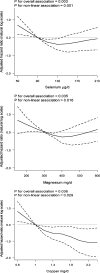Dietary intake of minerals and risk of esophageal squamous cell carcinoma: results from the Golestan Cohort Study
- PMID: 26016858
- PMCID: PMC4480669
- DOI: 10.3945/ajcn.115.107847
Dietary intake of minerals and risk of esophageal squamous cell carcinoma: results from the Golestan Cohort Study
Abstract
Background: Dietary factors have been hypothesized to affect the risk of esophageal cancer via different mechanisms, but the intake of minerals is understudied and the evidence is conflicting.
Objective: The objective was to evaluate the associations of dietary intake of minerals with risk of esophageal squamous cell carcinoma (ESCC).
Design: We used data from the Golestan Cohort Study, which was launched in a high-risk region for esophageal cancer in Iran. Participants were enrolled in 2004-2008 and were followed to 2014. Intakes of minerals were assessed with a validated food-frequency questionnaire. A Cox proportional hazards model was used to estimate HRs and 95% CIs of ESCC for dietary intakes of selected minerals.
Results: We identified 201 ESCC cases among 47,405 subjects. Calcium intake was significantly inversely associated with the risk of ESCC (HR per 100-mg/d increase: 0.88; 95% CI: 0.81, 0.96; P = 0.005; quartile 4 vs. quartile 1 HR: 0.49; 95% CI: 0.29, 0.82; P-trend = 0.013). Zinc intake was also inversely associated with ESCC, but the quartile association did not reach significance (HR per 1-mg/d increase: 0.87; 95% CI: 0.77, 0.98; P = 0.027; quartile 4 vs. quartile 1 HR: 0.56; 95% CI: 0.28, 1.12; P-trend = 0.097). The relations between dietary intakes of selenium, magnesium, and copper and risk of ESCC were nonlinear (P-nonlinear trend = 0.001, 0.016, and 0.029, respectively). There was no relation between dietary intake of manganese and the risk of ESCC.
Conclusion: The results suggest that higher intakes of calcium and zinc are associated with a lower risk of ESCC in a high-risk region of Iran.
Keywords: calcium; copper; esophageal cancer; magnesium; manganese; minerals; selenium; zinc.
© 2015 American Society for Nutrition.
Figures
References
-
- Siegel R, Naishadham D, Jemal A. Cancer statistics, 2012. CA Cancer J Clin 2012;62:10–29. - PubMed
-
- Jemal A, Bray F, Center MM, Ferlay J, Ward E, Forman D. Global cancer statistics. CA Cancer J Clin 2011;61(2):69–90. - PubMed
-
- Aghcheli K, Marjani HA, Nasrollahzadeh D, Islami F, Shakeri R, Sotoudeh M, Abedi-Ardekani B, Ghavamnasiri MR, Razaei E, Khalilipour E, et al. . Prognostic factors for esophageal squamous cell carcinoma—a population-based study in Golestan Province, Iran, a high incidence area. PLoS ONE 2011;6:e22152. - PMC - PubMed
-
- Islami F, Kamangar F, Nasrollahzadeh D, Moller H, Boffetta P, Malekzadeh R. Oesophageal cancer in Golestan Province, a high-incidence area in northern Iran—a review. Eur J Cancer 2009;45(18):3156–65. - PubMed
-
- Arnold M, Soerjomataram I, Ferlay J, Forman D. Global incidence of oesophageal cancer by histological subtype in 2012. Gut . 2015;64(3):381–7. - PubMed
Publication types
MeSH terms
Substances
Grants and funding
LinkOut - more resources
Full Text Sources
Other Literature Sources
Medical


